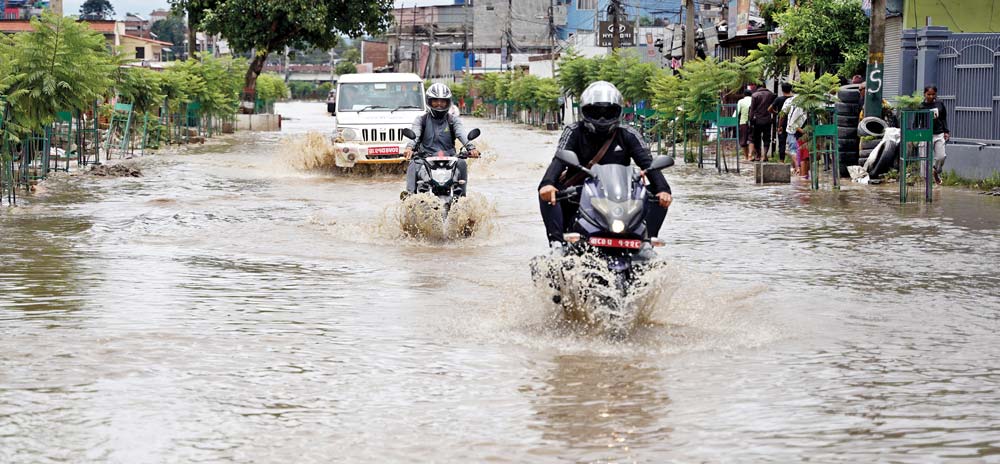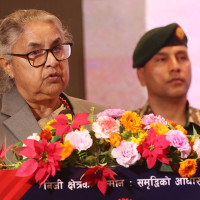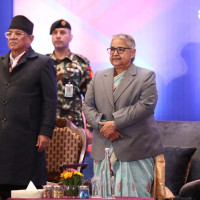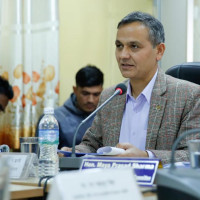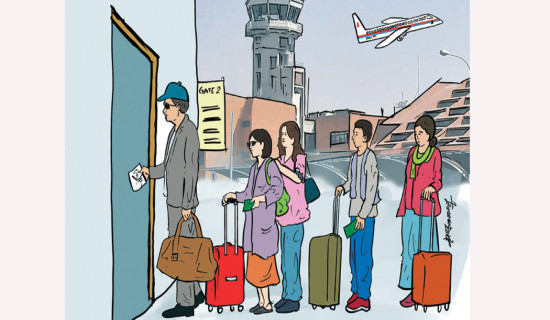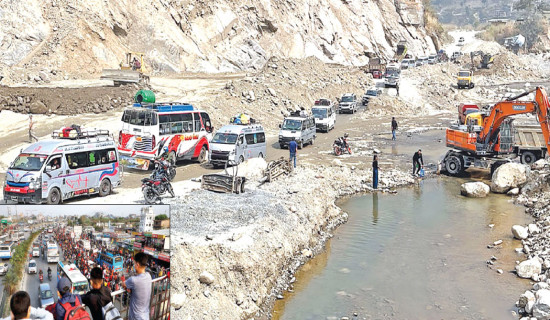- Thursday, 1 January 2026
Monsoon 2024: Highest casualties in 15 years with record rainfall
Kathmandu, Nov. 9: This year's monsoon disasters have caused the highest human casualties in Nepal since 2009 and five times more than last year’s, according to the statistics of the monsoon disaster updated by the National Disaster Risk Reduction Authority (NDRRMA) under the Ministry of Home Affairs.
The monsoon, which entered earlier than usual and exited late, triggered significant disasters this year. The monsoon that began on June 10 retreated on October 12, which means Nepal had a monsoon 10 days longer than average this year.
As the monsoon was longer, the disaster was also bigger. According to the NDRRMA, human casualties increased by 537 per cent compared to the last year. Between June 10 and October 12, 494 people were killed, 66 went missing and 532 were injured.
During this period, 2,136 monsoon-related incidents, affecting 5,937 families, were recorded.
From June 14, 2023, to October 15 last year, 891 monsoon-related incidents were recorded, in which 6,128 families were affected with 92 deaths, 30 missing cases and 168 injuries.
This year, floods alone affected 397 locations, with 90 human casualties, 18 cases of missing and 45 injuries. These floods impacted a total of 2,227 families. Likewise, 943 landslides were reported with 343 deaths, 48 missing cases and 276 injuries, directly impacting 1,561 families, according to the Authority.
Likewise, notable incidents of heavy rainfall were recorded in 538 locations where nine people died and 38 were injured. In total, 1,814 families were affected by the heavy rainfall, according to the Authority.
Lightning incidents were also high this monsoon season, with 258 incidents, 52 deaths and 164 injuries, affecting 335 families.
Between June 14 and October 15, 2023, 142 flood incidents were recorded with 16 deaths. In those incidents, 21 persons went missing, seven sustained injuries and 3,726 families were affected. Likewise, 459 cases of landslides with 45 deaths, nine missing cases and 50 injuries were reported last year. Landslides affected 1,948 families.
Similarly, 168 heavy rainfall incidents, with two deaths and 12 injuries, affecting 263 families, were reported in the monsoon last year. Similarly, 29 persons died, 99 sustained injuries and 191 families were affected in 122 lightning incidents.
16 per cent more rainfall
The country received more rainfall than average this year as predicted by meteorologists. In the last week of April, the Meteorology Department estimated a 55 per cent chance of above-average rainfall for this year.
This monsoon, the country received 1,691.3 millimetres of rainfall while the Department of Hydrology and Meteorology had expected 1,494.4 millimetres of rainfall during this period, based on the rainfall data of the past 30 years. The DHM reported a 16 per cent increase in rainfall this monsoon season.
This year, the Dodhara Meteorological Centre in Kanchanpur recorded the highest one-day rainfall in 77 years. Dodhara Meteorological Centre in Kanchanpur received 624 millimetres of rainfall in 24 hours from July 7 to 8.
The Hanumannagar Meteorological Centre in Kanchanpur recorded 537.6 millimetres, and the Sundarpur Centre recorded 555.8 millimetres of rainfall in 24 hours.
Since rainfall exceeded 100 millimetres in one hour, the department classified Kanchanpur's record-breaking rainfall as a 'Tarai cloudburst.'
During the retreating time of the monsoon, from September 26 to 28, 2024, there was heavy rainfall from Koshi to Lumbini Province. During this time, 'record-breaking' rainfall occurred in 25 locations across the country, including five locations in Kathmandu.
At Panipokhari in Kathmandu, the heaviest rainfall since 1971 was recorded, with 206.6 millimetres of rainfall from September 26 to 28. Previously, 198.0 millimetres was recorded on June 14, 1971.
Record-breaking rainfall was also recorded at Tribhuvan International Airport, Budhanilkantha, Jitpurphedi and Nagarjun in Kathmandu as well as in Godavari, Khumaltar, Tikathali, Khokana, and Chapagaun in Lalitpur.
In Daman, Makwanpur, 410 millimetres of rain was measured from September 27 to 28, surpassing the previous record of 373.2 millimetres on July 23, 1993. Similarly, in Khopasi, Kavrepalanchowk, 331.6 millimetres of rain was recorded from September 26 to 28, surpassing the previous record of 276.9 millimetres on September 3, 2015.
The heavy rains in October caused extensive damage along the banks of the Roshi River in Kavre and the Sunkoshi River.
It also caused the most damage in the Kathmandu Valley's riverbanks and the southern regions of Lalitpur, including Godavari Municipality, Konjyosom, Bagmati, and Mahankal rural municipalities. The government declared 71 local levels across 20 districts as disaster-affected areas for three months.
Province-wise damage reports
This monsoon season, Bagmati Province suffered the most damage. While there were 678 disaster-related incidents in Koshi Province, 276 deaths occurred in Bagmati Province. The rains from September 26 to 28 caused the most significant damage in Bagmati.
According to statistics, monsoon-related incidents resulted in 55 fatalities in Koshi, 16 in Madhes, 276 in Bagmati, 57 in Gandaki, 45 in Lumbini, 22 in Karnali and 23 in Sudurpashchim.
During the four-month monsoon season, 17 government offices, 96 schools, 11 health centres, and 109 suspension bridges sustained damage, according to the Ministry of Home Affairs. Additionally, 42 permanent bridges, Bailey bridges and 27 hydropower projects were damaged.
Regarding private residences, 2,902 houses were destroyed and 7,866 houses were partially damaged, according to the Home Ministry.
Poor disaster management
Meanwhile, Professor and geologist at Tribhuvan University Dr. Ranjan Kumar Dahal said that the government and its wings, mainly the NDRRMA and Meteorological and Hydrological officials and experts failed to disseminate and deliver risk communication in time.
"We only messaged and made the public aware by disseminating alert messages, but the concerned bodies failed to disseminate any information as to which areas and sectors were at a higher risk and the people of which areas should be shifted from the disaster-prone regions," said Dr. Dahal.
"There is no doubt, the government's agencies especially meteorological and NDRRMA did good preparations, but failed to provide 'risk communication' to the public identifying vulnerable regions," he said.
Similarly, former DG Somnath Sapkota of the Department of Mines and Geology said, "It appears that people and the government in Nepal become alert only after disaster strikes and makes large human casualties. There’s a lack of government plans for relocating people without making them feel the loss of their farmland and individuals' willingness to abandon their settlements which were at risk.”
While it is considered necessary for each local government to identify high-risk areas in their regions, map out risk assessments and relocate settlements near old landslides, experts said these measures were not implemented.
Sapkota pointed out that environmental impact assessments for projects are often done merely to gain approval, ignoring risks.
"Local governments are not incapable of involving or inviting geologists, hydrologists, and environmental experts to assess their regions. Taking such assessments seriously could at least help save lives, if not prevent disasters," he said.
Based on these assessments, experts believed that, when there was excessive rainfall, people would be able to assess their surroundings and question, 'Where are we, and what are the conditions around us?"

